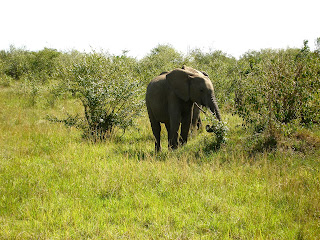(Scandinavian brown bear mother with cubs)
One group of Scandinavian scientists is interested in changing local attitudes to bears, and they hope to use education as their tool. In order to collect data on "normal" brown bear responses to unexpected meetings with humans, the researchers deliberately approached bears on 169 different occasions over a 3-year period. All approached bears had previously been fitted with radio collars, which not only allowed the scientists to locate the bears in order to perform each approach, but also to track the animals' movements before, during, and after the approach period. Walking and talking just like normal hikers would, the researchers passed upwind of the bears on trajectories aimed at taking them past the bears at a distance of 50 m. Many of the animals fled prior to this proximity, and the researchers made a note of the nearest approach that the animals tolerated. The scientists re-visited the sites several days later in order to collect information on habitat variables such as vegetation, the presence of bear daybeds, and the presence of carcasses--the last of which are often associated with more aggressive bear behavior. Habitat details were also evaluated for the areas to which bears relocated after being disturbed.
Although some bears stayed put and others moved away after encountering humans, in no case did any animals display aggressive behavior. Indeed, none of the "hikers" reported feeling threatened during the study. Despite the fact that the researchers knew the location of the bears prior to starting each approach, they only detected animals 15% of the time, whether by sight or sound or both. This suggests that humans may encounter bears--and experience no resulting catastrophes--much more than they realize. When bears were seen, it was not until an average distance of 18 m. In other words, the animals are good at remaining incognito, despite their large size.
(Frequency of brown bear observations in Sweden from 1998-2003)
In the majority (80%) of cases, bears immediately left their initial location and relocated elsewhere. Among those that stayed put, human proximity was tolerated to an average distance of 84 m, after which the bears finally ceded ground and fled. However, tolerance values ranged from 23-313 m, indicating that there is quite a lot of individual variation in bears' attitudes toward human proximity. Indeed, analyses indicated that older bears were more likely to remain in place than younger bears, suggesting that the animals may become more relaxed around humans as they gain more experience with them. Animal behaviors also varied as a result of their activity at the time of approach: "Passive" bears, or those that were sitting still when the approach began, were more likely to allow humans to come closer than were "active" bears, or those that were moving around. This may be related to differences in the bears' detection abilities during these behaviors. Bears were more likely to flee when they were approached by a larger group of hikers; they also appeared to be more easily disturbed during the berry season (summer and autumn), when they are bulking up prior to hibernation.
Using readings from the radio collars, the researchers were able to determine that bears moved an average of 1,173 m, but sometimes more than 6,000 m, after being disturbed. Additionally, the areas to which bears relocated were generally quite densely vegetated, enhancing their ability to hide. Cumulatively, all of these observations suggest that brown bears would really rather be left alone, and are more likely to achieve solitude by running away than by picking a fight with intruders. It is important to note that these results apply only to adult bears (>4 years old) and those without cubs or serious injuries. Juveniles, parents, and wounded animals may be less tolerant of humans; fortunately, however, encounters with such individuals are much less likely.
(A researcher collects data from anesthetized Scandinavian brown bears)
The authors hope that these findings can be incorporated into educational materials that can increase favorable attitudes to bears by reducing fear of the unknown. They particularly hope to reach hikers and berry-pickers, the groups most likely to encounter brown bears in the wild. As for the bears, the researchers hope to perform additional studies examining "unrecorded and unobserved" reactions to the approach of humans, such as increased heart rates and stress hormones. These can reduce health, survivorship, and breeding success--three very important factors in the conservation of threatened species like the Scandinavian brown bear.
---
For supplemental photos associated with this post, please visit the Anthrophysis pin board at Pinterest.
Moen, G.K., Stoen, O.-G., Sahlen, V., and Swenson, J.E. 2012. Behaviour of solitary adult Scandinavian brown bears (Ursos arctos) when approached by humans on foot. PLoS ONE 7(2):e31699.
Thanks to the following websites for providing the images used in this post:
http://www.bearproject.info/
http://www.bearproject.info/en/content/scandinavia
http://www.rovdjurscentrum.se/index.php?page=research




